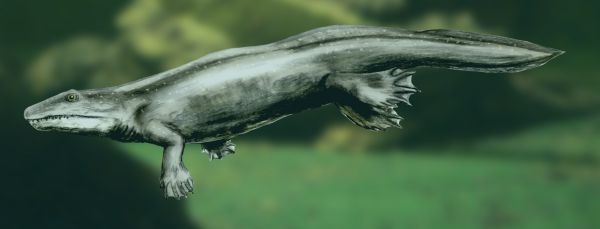
General Introduction
Fossils from the Late Devonian period, supposedly more than 360 million years old, were found in rocks in East Greenland. The fossils of this ancient animal made it clear that it had a generally developed system of fingers and limbs, so the species was quickly classified as a tetrapod. Ichthyostega was the first vertebrate animal found to have four limbs. However, it is now clear that it is challenging to call Ichthyostega a true tetrapod because of the primitiveness of the postcranial skeleton system, especially in comparison to modern quadrupedal animals. In addition, modern biology tends to believe that true tetrapods first appeared as a result of evolution only in the Triassic period, and thus Ichthyostega cannot be regarded as an official quadrupedal animal. Nevertheless, four limbs allowed the animal to move perfectly in shallow and swampy terrain, which gave Ichthyostega an evolutionary advantage. Thus, the pseudo-tetrapod could quickly attack the sea dwellers on the shores of ancient Greenland.
Skull structure
Unlike modern quadrupeds, Ichthyostega had a skull more resembling that of a typical fish. In general, the flat skull of the animal is arranged so that the lower jaw mates with the square-skull bone, as is characteristic of most reptiles. The depressions under the eyeballs are oval and shallow, located in the upper part of the central part of the skull. It is noteworthy that the torn bone in the Ichthyostega skull, unlike, for example, in humans, is adjacent not to the eye socket but to the nostril, which in turn were located at the lower section of the upper jaw. Analysis of the fossils also shows that Ichthyostega had gill covers on the backside of the skull, which fully confirms the aquatic lifestyle of the animal.
Structure of the postcranial skeleton
Although Ichthyostega had two pairs of limbs, the extinct pseudo tetrapod also had a caudal fin, which allowed it to move freely not only in shallow water but also in water. It is believed that the average length of the animal did not exceed one and a half meters, with the body ending in a long bony tail. The entire body was covered with many keratinized scales. Ichthyostega has a thorax in its abdomen, and the animal’s ribs could overlap, each forming a robust protective corset for the body: this was probably an adaptation to a mixed way of life. However, this skeletal structure did not allow Ichthyostega to bend its body freely. At the same time, the forelimbs were noticeably more powerful than the hind limbs, indicating the specificity of Ichthyostega gait. Each of the limbs had seven developed fingers connected by webbed tissue.